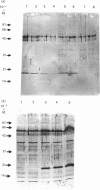Abstract
The cytotoxic response of the human large cell lung carcinoma line NCI H157 to exposure to the polyamine analogue N1 N12-bis(ethyl)spermine (BESpm) is preceded by an extremely high induction of spermidine/spermine N1-acetyltransferase (SSAT). The human enzyme has now been purified greater than 300-fold to apparent homogeneity and found to cross-react with antisera raised against rat liver SSAT. Although other acetylases are capable of acetylating polyamines using acetyl-CoA as the acetyl donor, the greater than 600-fold induction within 24 h was found to be specifically SSAT, since essentially all activity was precipitable by the specific antisera. The human enzyme appears to be similar to the rat enzyme in subunit size under reducing conditions (approximately 20 kDa), substrate specificity and kinetic parameters. Preliminary results using actinomycin D and cycloheximide suggested that the unusually high induction by N1 N12-bis(ethyl)spermine in the human lung cancer line result from new mRNA and protein synthesis. This hypothesis is further substantiated here by 'in vitro' translation experiments comparing poly(A) mRNA from control and treated cells. The large cell lung carcinoma line NCI H157 represents a useful system to produce large amounts of the SSAT protein and to study the molecular events responsible for the induction and control of this important polyamine-metabolic enzyme. By using this rich source of SSAT protein, a partial amino acid sequence was determined by N-terminal sequencing of endoproteinase Lys-C digestion fragments. Further, this system should be useful in determining whether there is an association between the unusually high induction of the acetylase and the observed cytotoxicity in the NCI H157 cells.
Full text
PDF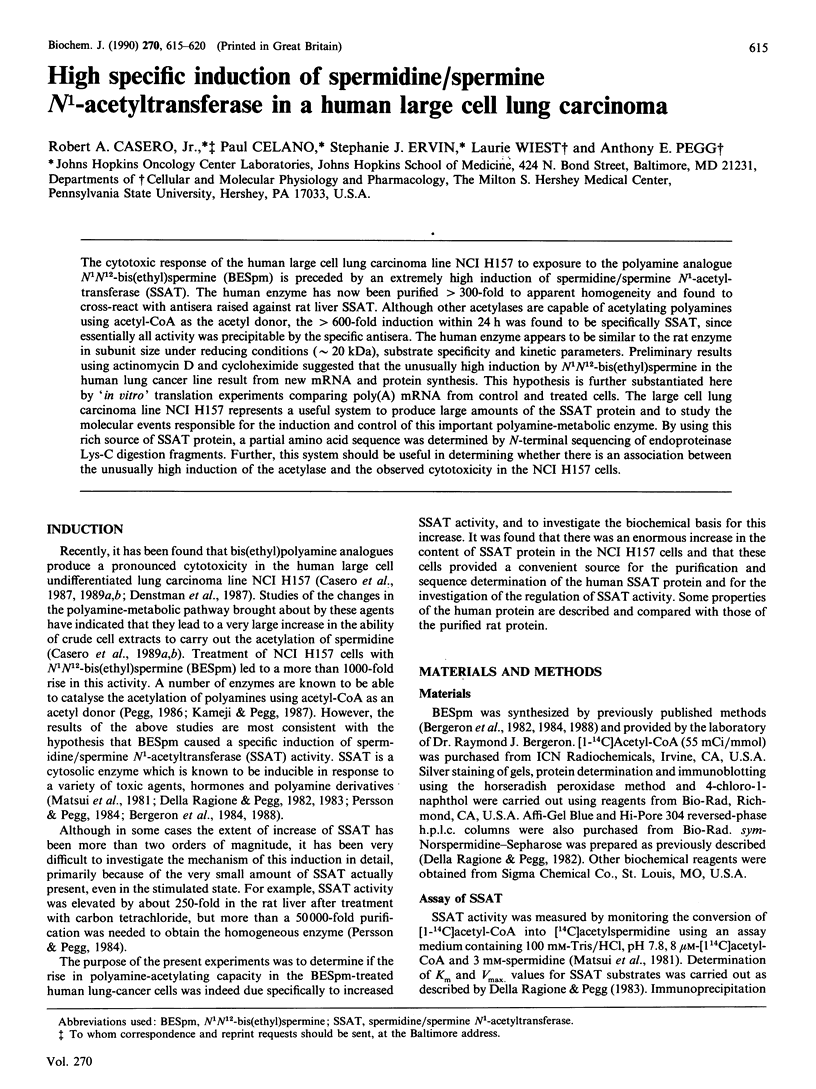
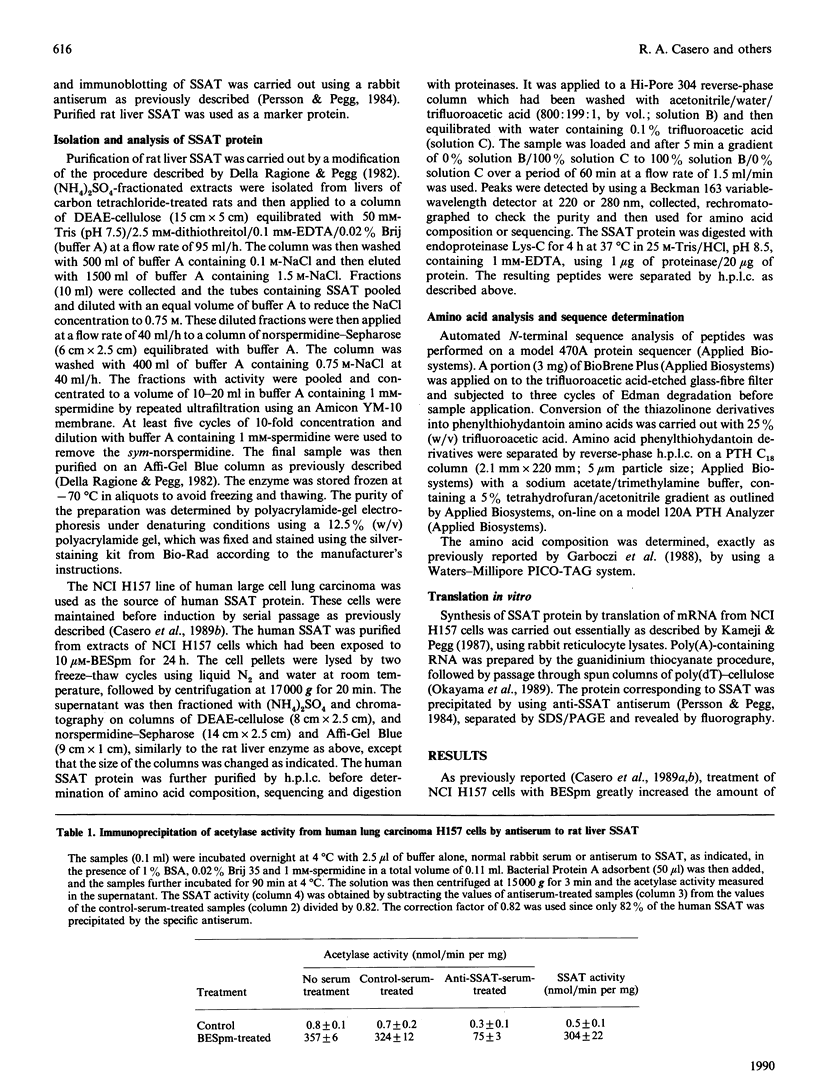
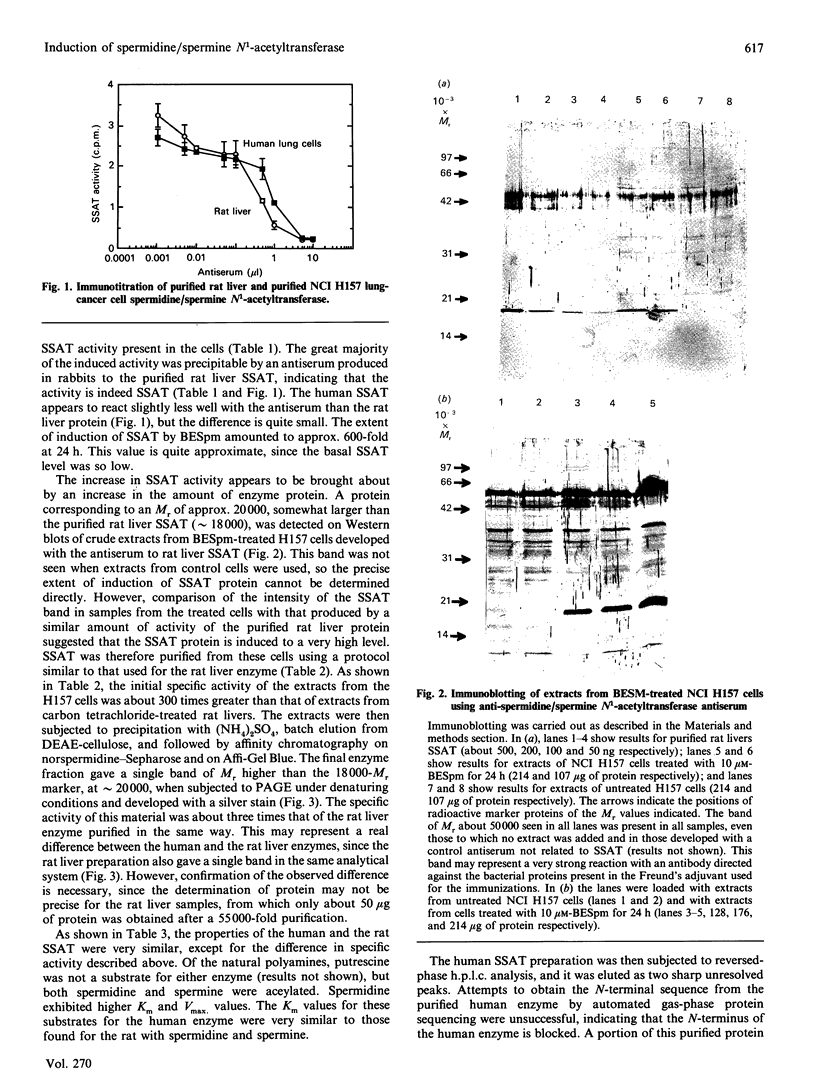
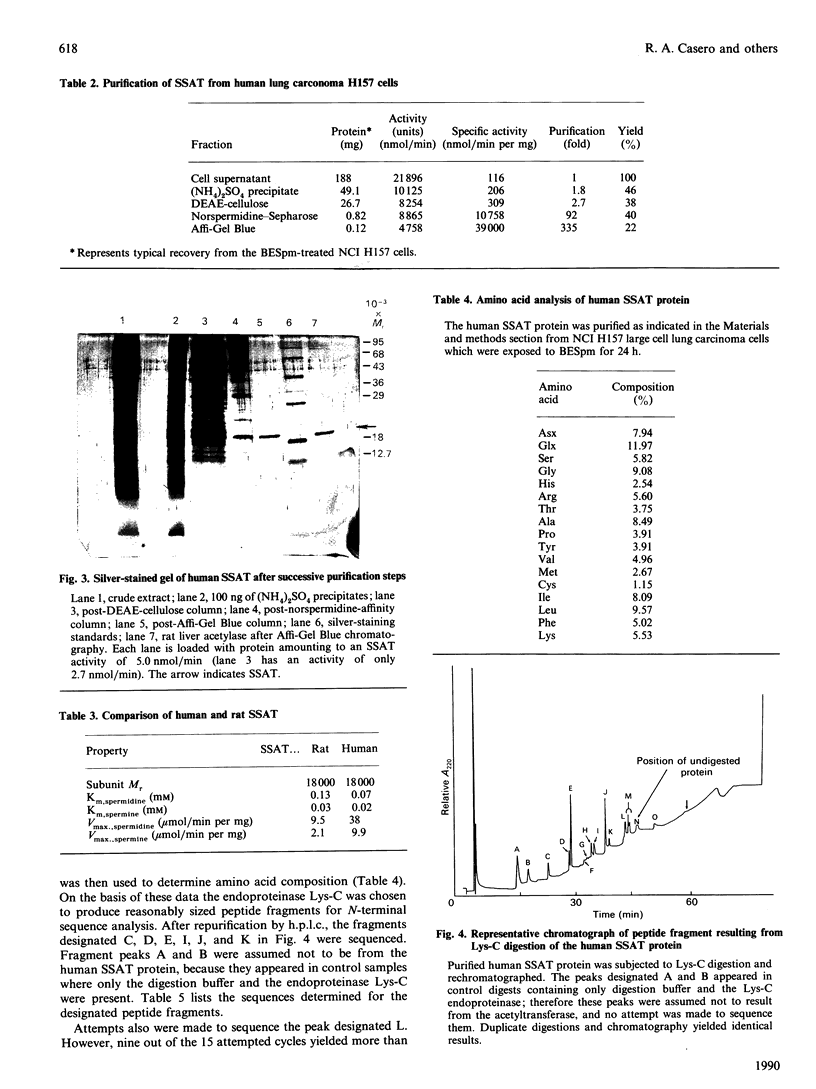
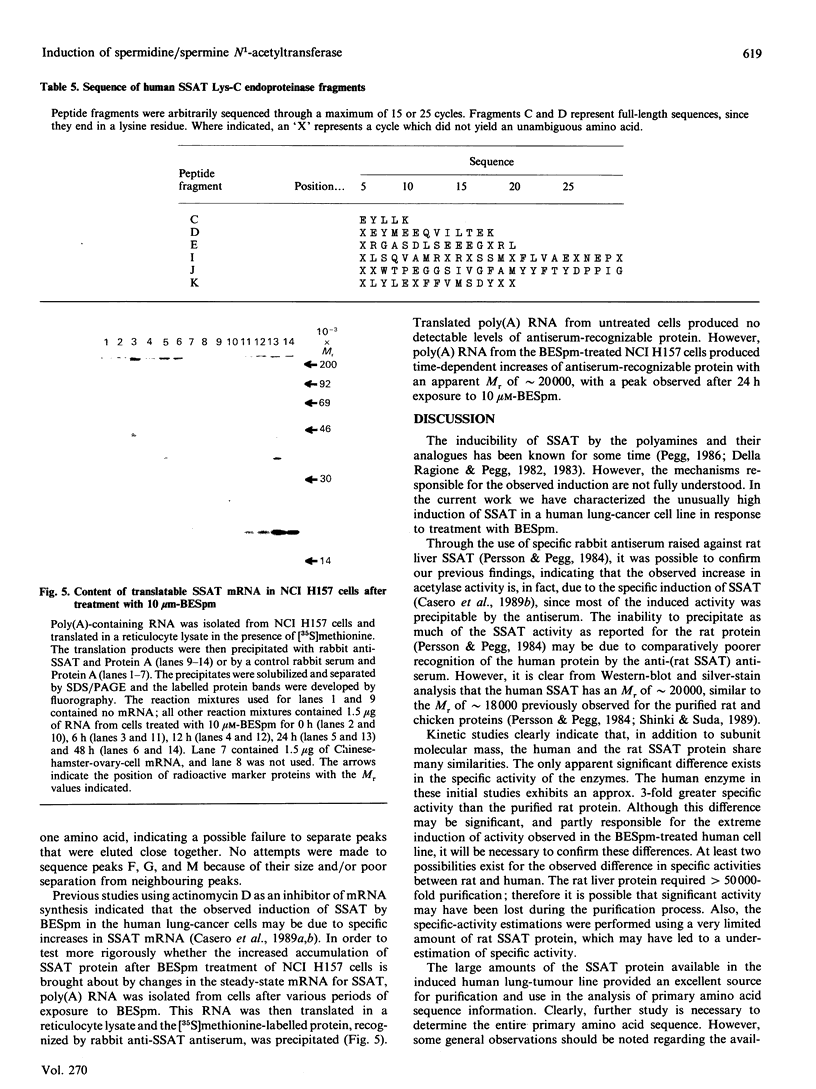
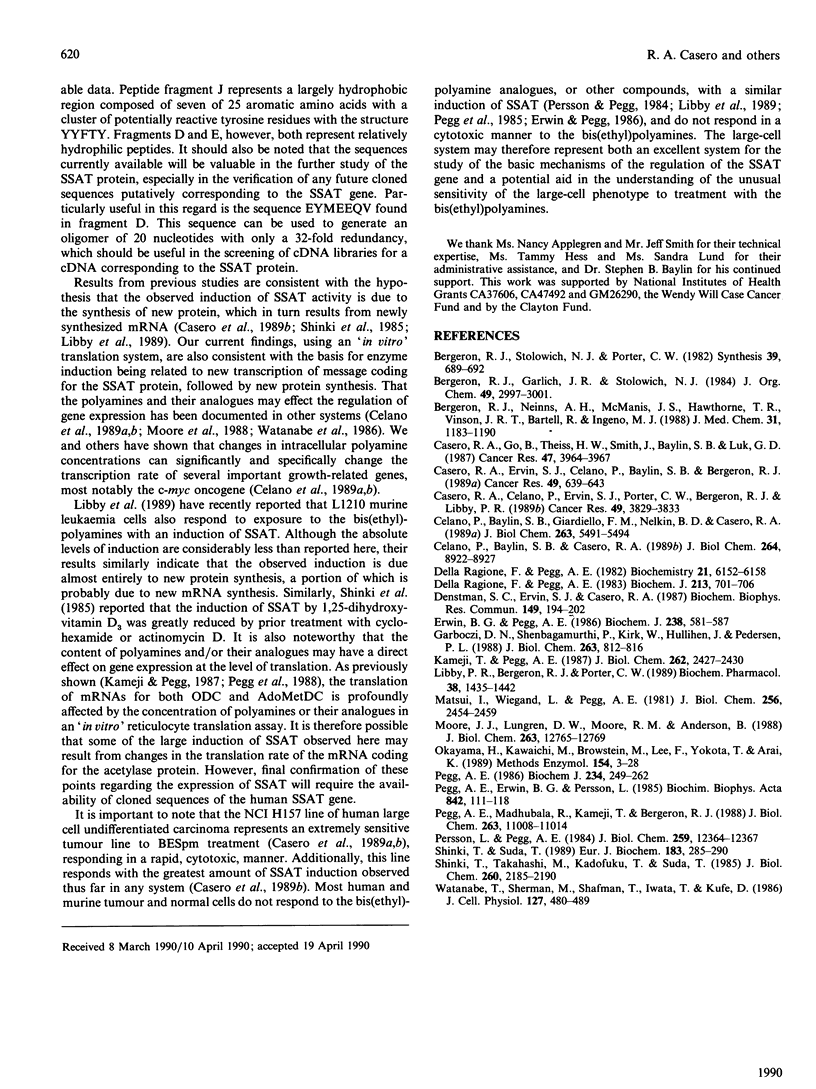
Images in this article
Selected References
These references are in PubMed. This may not be the complete list of references from this article.
- Bergeron R. J., Neims A. H., McManis J. S., Hawthorne T. R., Vinson J. R., Bortell R., Ingeno M. J. Synthetic polyamine analogues as antineoplastics. J Med Chem. 1988 Jun;31(6):1183–1190. doi: 10.1021/jm00401a019. [DOI] [PubMed] [Google Scholar]
- Casero R. A., Jr, Celano P., Ervin S. J., Porter C. W., Bergeron R. J., Libby P. R. Differential induction of spermidine/spermine N1-acetyltransferase in human lung cancer cells by the bis(ethyl)polyamine analogues. Cancer Res. 1989 Jul 15;49(14):3829–3833. [PubMed] [Google Scholar]
- Casero R. A., Jr, Ervin S. J., Celano P., Baylin S. B., Bergeron R. J. Differential response to treatment with the bis(ethyl)polyamine analogues between human small cell lung carcinoma and undifferentiated large cell lung carcinoma in culture. Cancer Res. 1989 Feb 1;49(3):639–643. [PubMed] [Google Scholar]
- Casero R. A., Jr, Go B., Theiss H. W., Smith J., Baylin S. B., Luk G. D. Cytotoxic response of the relatively difluoromethylornithine-resistant human lung tumor cell line NCI H157 to the polyamine analogue N1,N8-bis(ethyl)spermidine. Cancer Res. 1987 Aug 1;47(15):3964–3967. [PubMed] [Google Scholar]
- Celano P., Baylin S. B., Casero R. A., Jr Polyamines differentially modulate the transcription of growth-associated genes in human colon carcinoma cells. J Biol Chem. 1989 May 25;264(15):8922–8927. [PubMed] [Google Scholar]
- Celano P., Baylin S. B., Giardiello F. M., Nelkin B. D., Casero R. A., Jr Effect of polyamine depletion on c-myc expression in human colon carcinoma cells. J Biol Chem. 1988 Apr 25;263(12):5491–5494. [PubMed] [Google Scholar]
- Della Ragione F., Pegg A. E. Studies of the specificity and kinetics of rat liver spermidine/spermine N1-acetyltransferase. Biochem J. 1983 Sep 1;213(3):701–706. doi: 10.1042/bj2130701. [DOI] [PMC free article] [PubMed] [Google Scholar]
- Denstman S. C., Ervin S. J., Casero R. A., Jr Comparison of the effects of treatment with the polyamine analogue N1,N8 bis(ethyl)spermidine (BESpd) or difluoromethylornithine (DFMO) on the Topoisomerase II mediated formation of 4'-(9-acridinylamino) methanesulfon-m-anisidide (m-AMSA) induced cleavable complex in the human lung carcinoma line NCI H157. Biochem Biophys Res Commun. 1987 Nov 30;149(1):194–202. doi: 10.1016/0006-291x(87)91623-8. [DOI] [PubMed] [Google Scholar]
- Erwin B. G., Pegg A. E. Regulation of spermidine/spermine N1-acetyltransferase in L6 cells by polyamines and related compounds. Biochem J. 1986 Sep 1;238(2):581–587. doi: 10.1042/bj2380581. [DOI] [PMC free article] [PubMed] [Google Scholar]
- Garboczi D. N., Shenbagamurthi P., Kirk W., Hullihen J., Pedersen P. L. Mitochondrial ATP synthase. Interaction of a synthetic 50-amino acid, beta-subunit peptide with ATP. J Biol Chem. 1988 Jan 15;263(2):812–816. [PubMed] [Google Scholar]
- Kameji T., Pegg A. E. Inhibition of translation of mRNAs for ornithine decarboxylase and S-adenosylmethionine decarboxylase by polyamines. J Biol Chem. 1987 Feb 25;262(6):2427–2430. [PubMed] [Google Scholar]
- Libby P. R., Bergeron R. J., Porter C. W. Structure-function correlations of polyamine analog-induced increases in spermidine/spermine acetyltransferase activity. Biochem Pharmacol. 1989 May 1;38(9):1435–1442. doi: 10.1016/0006-2952(89)90182-2. [DOI] [PubMed] [Google Scholar]
- Matsui I., Wiegand L., Pegg A. E. Properties of spermidine N-acetyltransferase from livers of rats treated with carbon tetrachloride and its role in the conversion of spermidine into putrescine. J Biol Chem. 1981 Mar 10;256(5):2454–2459. [PubMed] [Google Scholar]
- Moore J. J., Lundgren D. W., Moore R. M., Andersen B. Polyamines control human chorionic gonadotropin production in the JEG-3 choriocarcinoma cell. J Biol Chem. 1988 Sep 5;263(25):12765–12769. [PubMed] [Google Scholar]
- Okayama H., Kawaichi M., Brownstein M., Lee F., Yokota T., Arai K. High-efficiency cloning of full-length cDNA; construction and screening of cDNA expression libraries for mammalian cells. Methods Enzymol. 1987;154:3–28. doi: 10.1016/0076-6879(87)54067-8. [DOI] [PubMed] [Google Scholar]
- Pegg A. E., Erwin B. G., Persson L. Induction of spermidine/spermine N1-acetyltransferase by methylglyoxal bis(guanylhydrazone). Biochim Biophys Acta. 1985 Oct 17;842(2-3):111–118. doi: 10.1016/0304-4165(85)90192-8. [DOI] [PubMed] [Google Scholar]
- Pegg A. E., Madhubala R., Kameji T., Bergeron R. J. Control of ornithine decarboxylase activity in alpha-difluoromethylornithine-resistant L1210 cells by polyamines and synthetic analogues. J Biol Chem. 1988 Aug 5;263(22):11008–11014. [PubMed] [Google Scholar]
- Pegg A. E. Recent advances in the biochemistry of polyamines in eukaryotes. Biochem J. 1986 Mar 1;234(2):249–262. doi: 10.1042/bj2340249. [DOI] [PMC free article] [PubMed] [Google Scholar]
- Persson L., Pegg A. E. Studies of the induction of spermidine/spermine N1-acetyltransferase using a specific antiserum. J Biol Chem. 1984 Oct 25;259(20):12364–12367. [PubMed] [Google Scholar]
- Ragione F. D., Pegg A. E. Purification and characterization of spermidine/spermine N1-acetyltransferase from rat liver. Biochemistry. 1982 Nov 23;21(24):6152–6158. doi: 10.1021/bi00267a020. [DOI] [PubMed] [Google Scholar]
- Shinki T., Suda T. Purification and characterization of spermidine N1-acetyltransferase from chick duodenum. Eur J Biochem. 1989 Aug 1;183(2):285–290. doi: 10.1111/j.1432-1033.1989.tb14926.x. [DOI] [PubMed] [Google Scholar]
- Shinki T., Takahashi N., Kadofuku T., Sato T., Suda T. Induction of spermidine N1-acetyltransferase by 1 alpha,25-dihydroxyvitamin D3 as an early common event in the target tissues of vitamin D. J Biol Chem. 1985 Feb 25;260(4):2185–2190. [PubMed] [Google Scholar]
- Watanabe T., Sherman M., Shafman T., Iwata T., Kufe D. Effects of ornithine decarboxylase inhibition on c-myc expression during murine erythroleukemia cell proliferation and differentiation. J Cell Physiol. 1986 Jun;127(3):480–484. doi: 10.1002/jcp.1041270319. [DOI] [PubMed] [Google Scholar]



